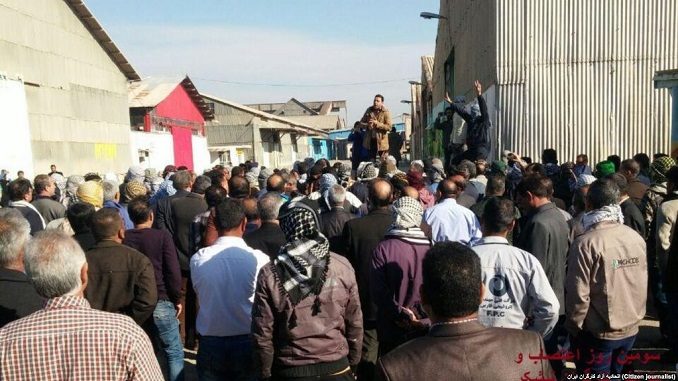
International Trade Union Confederation (ITUC) has asked its members around the world to protest against the “harassment” of labor activists and “systematic violation” of workers’ rights in Iran. Sources have told Radio Farda that ITUC, which consists of 331 unions in 163 countries with around 202 million members, has asked its rank and file to organize gatherings or send protest letters in this regard to embassies of the Islamic Republic of Iran.
A member of ITUC told Radio Farda that several Iranian activists and workers that have participated in guild related protests have been accused of acting against national security and convicted to long-term imprisonment or lashes. As a result, ITUC has decided to go beyond its past statements of condemnation and organize protests actions.
On Thursday February 1, in spite of the presence of suppressive forces who were on alert, and despite the cold weather, people in different cities of the country like Sanandaj, Ahvaz, Kermanshah, Isfahan, Zarrin Shahr, Shahrood, Hamedan, Tuyserkan, Mashhad, Dorood, Arak, Maragheh, Yazd, Rasht, and Tehran, rallied while chanting “ Death to the Dictator” and clashed with IRGC forces.
At the Vali Asr intersection in Tehran, the police force attacked the people at sunset. The brave youths continued their gathering, rallies, chanting slogans and clashed with regime’s mercenaries. Another group of people moved from the Abu Rayhan Ave. toward Valiasr Square while chanting slogans.
In the Vanak Square of Tehran, following the parade of the IRGC and the Basiji motorcyclist, young motorcyclists in a harmonious movement encouraged the people by chanting patriotic slogans and honking horns. The repressive forces were stationed in Amir Abad and Enqelab Square and the Northern Kargar Ave. In the Azadi Square, the regime has stationed a water-cannon truck.
In Rasht, hundreds of people chanting “Death to the Dictator”, “Khamenei, Shame on you, let go of the state” expressed their disgust against the Velayat-e faqih regime. The repressive forces responded by firing tear gas. In Sanandaj, the people chanted “Death to the Dictator” in the Enqelab, Khomeini and Azadi squares. The people clashed with the riot forces and set ablaze to a trailer and a motorcycle belonging to repressive forces. By slowing down the Internet, the regime prevents the people from sending information. Angry people set ablaze a Bassij base. The repressive forces have taken a water-cannon truck to disperse the people.
In Tuyserkan, the people’s gathering led to clashes with the repressive forces in Bahonar Ave. The regime’s mercenaries fired into the air to disperse people. In Isfahan, a group of people chanted “Death to the Dictator” and “Death to Khamenei” near Khaju Bridge which was attacked by the police. In the Zarrin-Shahr of Isfahan, people gathered at the Grand Mosque intersection in spite of the cold weather and severe repression. They chanted: “Death to Khomeini, Khamenei and Khatami, the three mercenaries.”
In recent years, Iran has been witnessing a wave of protests by workers and teachers due to low or delayed salaries, closure of workplaces due to suspicious bankruptcies, and layoffs.
Labor activists say that many of these problems are the result of mismanagement and corruption. In one case a court sentenced 17 former workers of a gold mine in West Azerbaijan Province, north-west of Iran to lashes due to participation in protests against their layoff.
According to Radio Farda sources, ITUC has asked its members to ask the Iranian government to dismiss the charges against the workers and workers’ activists and release all imprisoned workers.
ITUC is also concerned about thousands of workers at the Haft Tapeh sugar cane plantation in south-western province of Khuzestan, who have been protesting a long delay in their wages and demand the recognition of Haft Tapeh Workers’ Union as the official representative of the workers of this factory, the return of workers who have been fired “unjustly”, and the return of the factory to government ownership.
Haft Tapeh’s privatization under suspicious circumstances has raised questions and criticism. In an effort to improve the economy, the Iranian government has been trying to transfer government-owned companies to the private sector. However, due to widespread corruption, the privatization process is very ineffective and mostly results in the bankruptcy of the company.
